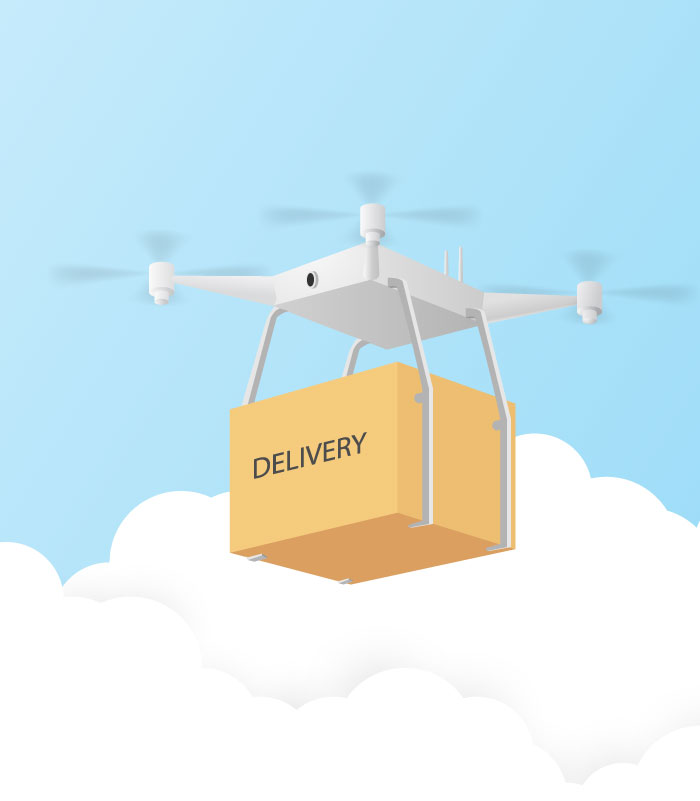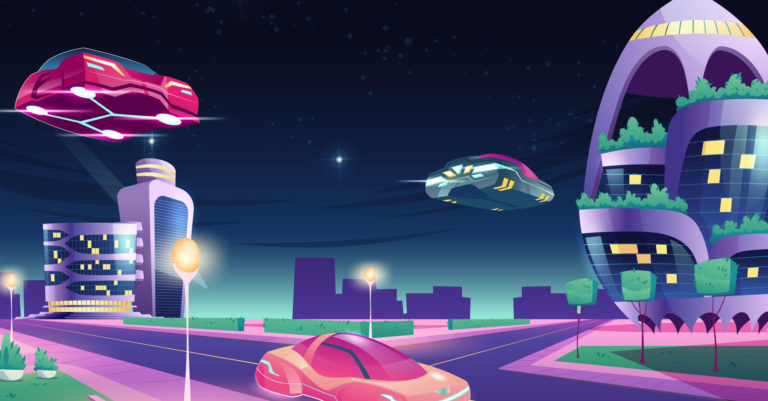Here come the Jetsons:
Cities Developing
in Futuristic Ways
by Edward Ring | March 2, 2023
Ever since humans invented the built environment, and cities developed along major crossroads and on the forks of navigable rivers, meeting the challenge of providing adequate transportation has been a nonnegotiable prerequisite to continued growth and prosperity.
In simpler times, dramatic and destructive solutions to relieving congestion in growing metropolises were a matter of course. History provides ample evidence of this, from powerful popes during the high Renaissance leveling ancient Roman temples and palaces to build new avenues for commerce, to Robert Moses blasting away tenement neighborhoods to build expressways in New York City in the last century. As we move further into the 21st century, thankfully, less disruptive transportation solutions are emerging. They’re coming none too soon.
As the worldwide urban population rises from an estimated 4.5 billion people today to peak at over 7 billion by 2050, cities are challenged to increase the density of buildings through infill – replacing lower density neighborhoods especially in the urban core with multi-story and high-rise residential towers. This expansion must be achieved as sustainably as possible, which new construction materials such as “green” concrete and cross-laminated timber, among others, promise to deliver.
But how will cities remain inviting, if most transportation conduits remain on surface streets and railways, at the same time as the suburban and urban population density is rising from 2,000 or 3,000 per square mile to 20,000 or 30,000 per square mile? How will these cities retain the ability to offer sufficient pedestrian space and park space if the surface transportation arteries are required to handle an order of magnitude increase in traffic?
A well-functioning city cannot merely fulfill the transportation requirements for people and commerce. The health and future of cities also relies on fulfilling four basic needs – fresh water, food, energy and waste management. To the extent these four essentials cannot be produced and processed within a densely populated city, they must rely on transportation corridors to swiftly move them in and out.

As the population density and absolute size of cities increases, the need for commensurate growth in transportation capacity will not be proportional. Some of the burden that might have traditionally required transportation capacity in past decades will go away. Growing percentages of workers who might traditionally have commuted into the urban core from their residences on the periphery will be working from home.
For better or for worse, additional millions of residents who might have used road and rail to travel to recreational destinations will be finding their tourism and social entertainment using stay-at-home video and virtual reality devices.
An equally significant way that transportation capacity will not have to completely keep pace with the growth in urban populations is through rapid advances in ways cities will be able to harvest rainwater and recycle wastewater, grow food, generate and store energy, and process garbage. High-rise residential and commercial buildings will be designed to harvest rainwater, reuse their wastewater, and generate energy from the sun and wind. Innovations, for example, in photovoltaic technology will allow buildings to use their windows as solar panels to convert sunlight into electricity.
Indoor agriculture will include aquaponic, hydroponic and aeroponic systems. Presumably, the emerging technologies of factory produced high-protein products will also be sited within high-density urban neighborhoods. Cities will not become entirely self-sufficient, but they will become far more so than ever before in history.
As megacities grow, their need for rapid and uncongested transportation conduits will grow well beyond what exists today as they build new infrastructure and refine existing infrastructure. It is no longer necessary to solve this by relying solely on ground-based road and rail.
Cities can preserve precious and limited surface space for human enjoyment by finding transportation solutions in the air and underground. This may sound fanciful, but it’s nothing of the sort. At this moment, virtually every major automotive and aerospace company – along with dozens of high-tech companies – have been developing prototype passenger drones.

Already, we are seeing freight drones being used by Amazon in two small U.S. cities, one in Northern California, another in Texas. The company intends to roll out delivery drone service – to be called “Prime Air” – nationwide by 2024. Amazon is not alone. At least 12 companies are developing drone delivery vehicles. But that’s just the beginning of a revolution in air transportation.
As reported last year by Air Mobility News, there are five passenger drone companies now listed with a market value over $1 billion: AeroVironment, Joby, Vertical Aerospace, Archer Aviation and Lilium. An additional seven companies are publicly listed with a market cap over $100 million: Ehang, ACSL, Parrot, AgEagle, Drone Delivery Canada, ONDAS and Red Cat.
Joby Aviation’s “eVTOL” (electronic Vertical TakeOff and Landing) “taxi drone” prototype has demonstrated a range of over 150 miles. Their drone’s range is extended because, while it takes off like a helicopter, in level flight it has a wing that provides lift. The six rotors on Joby’s eVTOL point straight up to provide vertical lift during takeoff, then rotate 90 degrees to function as conventional propellers during flight. What the V-12 Osprey does for the military with turbojet-powered rotors, Joby does with electric motors and a battery.
Most passenger drone duty cycles will not require a range in excess of 20 miles, which is the range of the Ehang 216, a fully autonomous taxi drone that can transport two passengers and has already carried out over 1,000 test flights. Dozens of emerging companies are testing passenger drone prototypes, one of them, based in Sweden, is leaning into the novelty of it by naming their company Jetson Aero. But the biggest companies on Earth are also involved in the race to make drone transportation ubiquitous.

Among aerospace companies, these would include Boeing, Airbus and Raytheon. Every major airline is investing in passenger drone service, including Delta, American Airlines, United Airlines and Lufthansa. Major automakers are deeply involved in the race to the air. These include Volkswagen, Honda, Toyota, and, of course, Tesla. Not to be outdone, Apple is rumored to be working on a flying car, as is Microsoft, in partnership with Hyundai.
When it comes to taxis roving the airways of big cities like a scene out of the Sci Fi movie Fifth Element, however, the flood of investors and entrants in the space doesn’t mean it’s going to be easy. Google just shut down its flying car startup, Kitty Hawk, after 12 years, although research will continue in partnership with Boeing. And while the FAA is working closely with civil aviation authorities to regulate the dawn of advanced air mobility, it is a process that will happen gradually.
Sooner or later, urban residents may count on seeing delivery drones, then passenger drones – thus making the skyline more interesting. A parallel revolution is happening out of sight. The revolution in underground tunneling technology has been quietly advancing for several years.
The global leader in tunneling systems is Herrenknecht AG, founded in 1975 and lead contractor on thousands of tunnel boring projects around the world. The company’s projects range from digging underground metro systems in cities on every continent, to the Gotthard Base Tunnel in Switzerland, which at 35 miles is the longest tunnel in the world. Leave it to the Germans to design machines several hundred feet long, and up to 60 feet in diameter, engineered to delve through the earth like a Sandworm out of Frank Herbert’s novel Dune.
But where the Germans lead, innovators nip at their heels. The Boring Company, founded by (who else?) Elon Musk, claims the field of tunneling has not taken advantage of new technologies. They propose to lower the cost of tunneling by a factor of between four and 10 by: 1) Tripling the power output of the tunnel boring machine’s cutting unit; 2) Continuously tunneling instead of alternating between boring and installing supporting walls; 3) Automating the tunnel boring machine, eliminating most human operators; and 4) Replacing diesel motors with electric.
Musk has said “the construction industry is one of the only sectors in our economy that has not improved its productivity in the last 50 years.” The Boring Company has already begun construction on the “Vegas Loop” – underground service extensions that will deliver passengers from Las Vegas Airport to destinations on the famed Vegas strip in three minutes instead of the typical 30 minutes required using above-ground transportation.
Beneath Los Angeles, The Boring Company has already completed and is testing a prototype tunnel, which is 1.14 miles long. They claim it was built at a cost of only $10 million. If the Boring Company revolutionizes tunneling the way SpaceX revolutionized access to low-earth orbit, the functions of the vertical city will indeed expand down into the earth as well as up into the sky.
As the Herrenknecht website puts it, “Our high-tech machines enable high advance rates in any geology with maximum safety for buildings, infrastructures and personnel … modern, integrated tunnel systems for metro, road, railway, passenger, supply and disposal tunnels are the result.”
The technologies needed deliver flying cars are arriving fast, as are cost-effective tools – OK, gargantuan tools – to build bigger and upgraded underground transportation conduits. Above the skyline and under the streets, expect cities in the future to expand vertically, relieving congestion at the same time as more people live better lives on the same footprint of land.
Edward Ring is a co-founder of the California Policy Center and the author of “The Abundance Choice: Our Fight for More Water in California.”
Manipulated graphics ©Vecteezy
